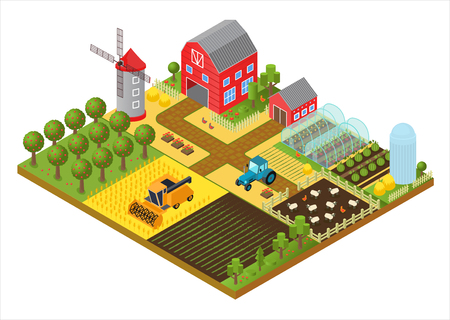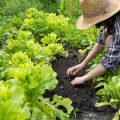1. Understanding Succession Planting
Succession planting is a smart gardening technique that helps you get the most out of your garden space by staggering plantings of crops to ensure a continuous harvest throughout the growing season—and even year-round in some areas. Rather than planting everything at once and getting one large harvest, you spread out your plantings over time or rotate different crops into the same area as others finish producing.
What Is Succession Planting?
Succession planting involves sowing seeds or transplanting seedlings in intervals so that new crops are always growing as older ones are harvested. This can mean planting the same crop every couple of weeks, rotating fast-maturing crops with slower ones, or switching out cool-season vegetables for warm-season varieties as the seasons change.
Why Use Succession Planting?
This method helps maximize your garden’s productivity and ensures you always have fresh produce on hand. It also reduces waste from overwhelming harvests and makes better use of limited garden space—especially important for small backyard gardens or raised beds.
Key Benefits of Succession Planting:
| Benefit | Description |
|---|---|
| Continuous Harvest | Enjoy fresh veggies all season long instead of one big crop. |
| Maximized Yields | Grow more food in the same space by rotating crops quickly. |
| Pest and Disease Management | Diversified planting times can reduce pest build-up and soil diseases. |
| Efficient Use of Space | Keep your beds full by replacing harvested plants with new ones. |
| Better Planning for Storage and Use | A steady flow of produce means less spoilage and more manageable preserving. |
Common Succession Planting Methods:
- Same Crop, Staggered Timing: Plant a row of lettuce every 1–2 weeks to avoid harvesting it all at once.
- Diverse Crops in Sequence: Follow early peas with bush beans, then plant fall spinach in the same spot.
- Intercropping: Grow quick-maturing radishes between rows of slower-growing carrots.
- Cropping by Season: Start with cool-season crops in spring, switch to heat-lovers in summer, and return to cold-hardy greens in fall.
Example Succession Plan (Cool to Warm Season)
| Season | Crops | Notes |
|---|---|---|
| Early Spring | Lettuce, Spinach, Radish | Fast-growing; ready in 30–45 days. |
| Late Spring/Early Summer | Bush Beans, Cucumbers, Zucchini | Plant after early crops are harvested. |
| Midsummer/Fall | Kale, Beets, Carrots | Crops that tolerate cooler temps as summer fades. |
| Late Fall/Winter (in mild zones) | Mâche, Winter Lettuce, Garlic (for next year) | Select frost-hardy varieties or use cold frames. |
The beauty of succession planting lies in its flexibility. Whether youre working with a few containers on a patio or a larger backyard garden, this technique allows you to grow smarter—not just more. In the following sections, we’ll dive deeper into planning strategies and crop combinations that work well together throughout the year.
2. Choosing the Right Crops for Each Season
When practicing succession planting, one of the most important steps is selecting crops that match your region’s seasonal climate patterns. The United States has a wide range of growing zones, so understanding whether you live in the North, South, Midwest, or West will help determine what to plant and when.
Understanding Cool-Season vs. Warm-Season Crops
Cool-season crops thrive in the cooler temperatures of spring and fall. They can tolerate light frosts and often bolt (go to seed) when temperatures rise. On the other hand, warm-season crops need higher temperatures and are damaged by frost. Knowing the difference helps you rotate crops effectively throughout the year.
| Cool-Season Crops | Warm-Season Crops |
|---|---|
| Lettuce | Tomatoes |
| Spinach | Cucumbers |
| Broccoli | Peppers |
| Kale | Squash |
| Peas | Corn |
Selecting Crops by U.S. Region
Northern States (e.g., Minnesota, Maine)
The shorter growing season means you’ll want to start cool-season crops early indoors or in cold frames. Use the summer months for warm-season vegetables, then switch back to cool-season varieties in late summer for a fall harvest.
Southern States (e.g., Texas, Florida)
Mild winters allow for winter gardening with cool-season crops. Avoid planting cool-season crops during hot summers; instead, focus on heat-loving varieties and plan for multiple plantings due to longer growing seasons.
Midwestern States (e.g., Illinois, Ohio)
This region experiences all four seasons distinctly. Begin with cool-season crops in early spring, transition to warm-season crops after the last frost date, and return to cool-season varieties in late summer or early fall.
Western States (e.g., California, Oregon)
The West varies widely depending on elevation and proximity to the coast. Coastal areas may allow year-round growing with fewer weather extremes, while inland areas should follow more traditional seasonal rotations based on local frost dates.
Tips for Crop Rotation and Succession Planning
- Stagger planting dates: Sow seeds every 1–2 weeks instead of all at once to extend your harvest window.
- Follow crop families: Rotate between different plant families (e.g., legumes, brassicas, nightshades) to reduce pest buildup and soil nutrient depletion.
- Use interplanting: Grow fast-maturing crops like radishes alongside slower-growing ones like carrots to maximize space and time.
- Keep records: Track what you plant and when so you can refine your strategy each year based on what works best in your location.

3. Timing and Scheduling for Continuous Harvest
One of the most important parts of successful succession planting is getting the timing right. To enjoy fresh vegetables throughout the year, youll need to plan your sowing and transplanting dates carefully. This means knowing your local frost dates, understanding how long each crop takes to mature, and keeping track of when to replant.
Know Your Frost Dates
Your first and last frost dates determine the length of your growing season. In most areas of the U.S., these dates can vary widely. Be sure to look up your zip code on a reliable gardening website or check with your local extension office. Knowing these dates helps you plan when to start seeds indoors, transplant outdoors, and plant fall or winter crops.
Create a Planting Calendar
A planting calendar is your best friend when it comes to succession planting. It helps you map out what to plant and when so that you always have something growing and ready to harvest. Here’s a simple way to break it down:
| Season | Example Crops | Planting Tips |
|---|---|---|
| Spring | Lettuce, radishes, peas | Start as soon as soil can be worked; use row covers for early protection |
| Summer | Tomatoes, beans, cucumbers | Succession sow every 2-3 weeks for continuous yield |
| Fall | Kale, carrots, spinach | Start seeds in late summer; use shade cloth during hot spells |
| Winter (in mild zones or with protection) | Garlic, winter greens, mache | Use cold frames or hoop houses; choose cold-hardy varieties |
Staggered Sowing for Extended Harvests
Instead of planting everything at once, stagger your sowings every couple of weeks. For example, if youre growing bush beans, plant a new row every two weeks during their optimal season. This way, as one batch finishes producing, another is just starting—giving you a steady supply rather than one big harvest.
Quick Tip:
Use a simple spreadsheet or gardening app to track when you planted each crop and when it should be ready to harvest. Many apps can even send reminders!
Match Crops by Maturity Dates
Crops grow at different speeds. By choosing varieties with varying maturity times—like early, midseason, and late—you can keep your garden productive without overcrowding. For example:
| Crop | Maturity Type | Days to Harvest |
|---|---|---|
| Corn (Early) | Early | 65 days |
| Corn (Main) | Main Season | 80 days |
| Corn (Late) | Late Season | 95 days |
This strategy allows you to use space efficiently and avoid overwhelming harvests all at once.
If you stay organized and adjust based on your local climate and experience, succession planting becomes second nature—and your garden will reward you with fresh produce nearly year-round.
4. Soil Health and Bed Preparation
When practicing succession planting for year-round harvests, healthy soil is the foundation of your garden’s success. Growing multiple crops in the same space throughout the season can quickly drain nutrients from the soil, so its essential to maintain fertility and structure through proper care and preparation.
Why Soil Fertility Matters
Each crop you plant draws different nutrients from the soil. Without replenishing those nutrients, your plants may struggle to grow, leading to smaller yields or increased susceptibility to pests and disease. Keeping your soil rich and balanced ensures each new planting has what it needs to thrive.
Composting for Continuous Planting
Adding compost regularly is one of the best ways to keep your soil healthy between plantings. Compost improves soil texture, retains moisture, and provides a slow-release source of nutrients that support ongoing plant growth.
How to Use Compost Effectively:
- Before planting: Mix 1–2 inches of compost into the top 6 inches of soil.
- Between successions: Remove spent plants, loosen the soil, and add another layer of compost before replanting.
- Top-dressing: For growing crops, apply a thin layer around plants to boost nutrition without disturbing roots.
Preparing Beds for Multiple Crops
Succession planting requires thoughtful planning when it comes to bed preparation. After each harvest, its important to reset the growing area so its ready for the next crop rotation.
Key Steps in Bed Preparation:
- Clear debris: Remove old plants, weeds, and mulch from previous crops.
- Aerate the soil: Use a garden fork or broadfork to gently loosen compacted areas without turning deeper layers unnecessarily.
- Add amendments: Depending on what was grown previously, you may need to add organic fertilizers or minerals (like bone meal or greensand) based on soil test results.
- Water deeply: Moisture helps activate microbes and break down added organic matter before replanting.
Nutrient Needs Based on Crop Type
Certain crops are heavier feeders than others. To avoid depleting your soil, rotate plant families and adjust your fertilization plan accordingly. Heres a simple guide:
| Crop Type | Nutrient Needs | Soil Prep Tip |
|---|---|---|
| Leafy Greens (Lettuce, Spinach) | High nitrogen | Add compost + fish emulsion or blood meal |
| Fruit-bearing (Tomatoes, Peppers) | Balanced NPK + calcium | Add compost + crushed eggshells or lime |
| Root Crops (Carrots, Beets) | Moderate nutrients | Avoid high nitrogen; use compost + wood ash sparingly |
| Legumes (Beans, Peas) | Add nitrogen to soil | No extra nitrogen needed; inoculate seeds if possible |
A Quick Tip:
If you’re planting fast-growing crops like radishes or salad greens between main crops, consider using them as “soil boosters.” Their short growth cycle allows you to refresh beds without long downtime.
Caring for your soil isn’t just a one-time task—it’s an ongoing part of successful succession planting. With good composting habits and smart bed prep techniques, you’ll be able to grow healthy crops in every season without wearing out your garden beds.
5. Extending the Growing Season with Season Extension Tools
Succession planting doesn’t have to stop when the weather turns cold. With the help of season extension tools like row covers, cold frames, and greenhouses, gardeners in many parts of the United States can continue harvesting fresh produce well beyond the traditional growing season. These tools are especially useful for early spring and late fall plantings—and in milder zones, they can even make year-round growing possible.
Row Covers
Row covers are lightweight fabrics that are laid directly over crops or supported by hoops to form low tunnels. They help protect plants from frost, wind, and pests while allowing sunlight, air, and water to pass through. Row covers are ideal for cool-season crops like lettuce, spinach, radishes, and carrots.
Types of Row Covers:
| Type | Best Use | Temperature Protection |
|---|---|---|
| Lightweight (0.5 oz) | Pest control and light frost protection | Down to 28–30°F (-2 to -1°C) |
| Mediumweight (0.9 oz) | Extended fall harvests | Down to 26°F (-3°C) |
| Heavyweight (1.5 oz) | Winter protection in mild climates | Down to 24°F (-4°C) or lower |
Cold Frames
A cold frame is a bottomless box with a transparent lid that traps heat from the sun, creating a mini greenhouse effect. It’s great for hardening off seedlings in spring or protecting greens during colder months. Cold frames work best when placed against a south-facing wall for maximum sun exposure.
Crops That Do Well in Cold Frames:
- Lettuce
- Kale
- Mâche (corn salad)
Greenhouses and High Tunnels
If youre serious about extending your growing season—or even gardening year-round—a greenhouse or high tunnel might be worth the investment. These structures offer more controlled environments where you can grow both cool- and warm-season crops longer than would be possible outdoors.
Main Differences Between Greenhouses and High Tunnels:
| Greenhouse | High Tunnel (Hoop House) | |
|---|---|---|
| Structure | Permanent with heating/cooling options | Tunnel-shaped, often unheated |
| Cost | Higher initial investment | More affordable setup |
| Crops Grown | Tropical plants, tomatoes, cucumbers year-round | Lettuce, kale, carrots into winter months |
The Benefits for Succession Planting
Incorporating these tools into your succession planting strategy means you can start earlier in the spring and keep planting later into the fall. In warmer USDA zones like 8-10, its even possible to have continual harvests all year long with proper planning and protection.
A Quick Seasonal Planting & Tool Guide:
| Season | Crops to Plant | Recommended Tool(s) |
|---|---|---|
| Early Spring | Lettuce, peas, spinach | Row covers or cold frame |
| Summer Succession | Bush beans, carrots, beets (for fall harvest) | No cover needed (warm temps) |
| Late Fall/Winter Prep (Zones 6+) | Kale, spinach, mâche, arugula | Cloches, row covers, or high tunnel |
| Mild Winter (Zones 8–10) | Lettuce, herbs, root veggies continually sown every few weeks | Covers optional; greenhouses maximize yields |
No matter where you live in the U.S., using these season extension tools lets you get more out of each square foot of your garden. By combining them with smart succession planting techniques, youll enjoy fresh produce much longer throughout the year.
6. Common Challenges and How to Overcome Them
Succession planting is a smart way to keep your garden producing fresh veggies all year long, but it does come with its own set of challenges. Understanding these common pitfalls—and knowing how to handle them—can make a big difference in your gardening success.
Pest Buildup
When you’re planting crops back-to-back in the same area, pests can become a real problem. Insects like aphids, squash bugs, and cabbage worms often find continuous plantings irresistible.
Solutions:
- Crop Rotation: Rotate plant families (like brassicas, nightshades, and legumes) from one bed to another each season to break pest cycles.
- Companion Planting: Grow pest-repelling plants like marigolds or basil alongside your crops.
- Row Covers: Use lightweight fabric covers to protect young plants from pests without chemicals.
Soil Fatigue
Planting repeatedly in the same soil can deplete nutrients and reduce yields over time. This is known as crop fatigue or soil exhaustion.
Solutions:
- Add Compost Regularly: Replenish organic matter between plantings with homemade compost or well-rotted manure.
- Crop Rotation (Again!): Switching plant types helps balance nutrient use and supports soil health.
- Cover Crops: Sow quick-growing cover crops like clover or buckwheat during gaps in planting to enrich the soil naturally.
Poor Timing and Planning
If you don’t plan your succession schedule carefully, you might end up with overcrowded beds or harvest gaps where nothing’s ready to pick.
Solutions:
- Create a Planting Calendar: Sketch out what you’ll plant and when based on your USDA hardiness zone and frost dates.
- Select Quick-Maturing Varieties: Choose seeds that mature quickly so you can fit more plantings into your season.
- Use Transplants Strategically: Start seedlings indoors while other crops finish growing outdoors for seamless transitions.
Disease Carryover
Certain diseases like powdery mildew or blight can persist in the soil or on leftover plant debris, especially with continuous cropping.
Solutions:
- Sanitize Garden Tools: Clean tools between uses to avoid spreading disease from one crop to the next.
- Avoid Overhead Watering: Water at the base of plants to reduce moisture on leaves and prevent fungal issues.
- Select Disease-Resistant Varieties: Many seed companies offer cultivars bred for resistance to common diseases.
Nutrient Imbalance
If youre constantly harvesting without replacing nutrients, your plants may suffer from deficiencies—yellowing leaves, stunted growth, or poor yields.
| Nutrient Deficiency | Signs | Nutrient Source |
|---|---|---|
| Nitrogen | Pale green or yellow leaves, slow growth | Blood meal, fish emulsion, composted manure |
| Phosphorus | Purple-tinted leaves, weak roots | Bone meal, rock phosphate |
| Potassium | Browning leaf edges, poor fruit development | Kelp meal, wood ash (in moderation) |
Lack of Space for Continuous Planting
If your garden space is limited, fitting in successive crops can be tricky.
Solutions:
- Use Vertical Space: Grow vining crops like cucumbers or pole beans on trellises to free up ground space.
- Sow in Containers: Use pots or raised beds for flexibility and easy crop turnover.
- Tight Spacing Techniques: Practice square foot gardening or intensive spacing methods for higher yield per square foot.
Tackling these common succession planting issues head-on will not only keep your garden productive through every season—it’ll also help build healthier soil, stronger plants, and a more rewarding gardening experience overall!


